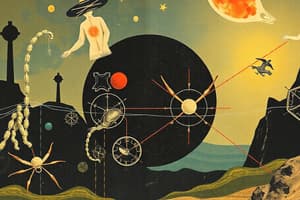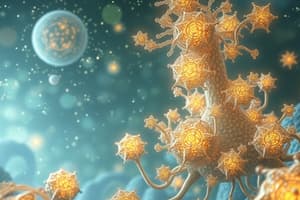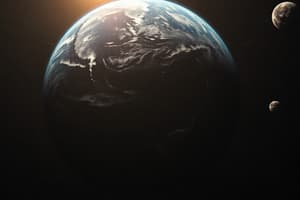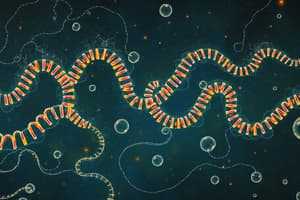Podcast
Questions and Answers
Which property of life describes how organisms maintain stable internal conditions?
Which property of life describes how organisms maintain stable internal conditions?
- Cellular Organization
- Metabolism
- Reproduction
- Homeostasis (correct)
What is the main function of ATP in living organisms?
What is the main function of ATP in living organisms?
- Regulating body temperature
- Storing genetic information
- Transporting nutrients
- Carrying energy within cells (correct)
Which of the following statements about reproduction is true?
Which of the following statements about reproduction is true?
- Asexual reproduction involves two parents.
- Asexual reproduction produces genetically identical offspring to one parent. (correct)
- Sexual reproduction only occurs in unicellular organisms.
- Sexual reproduction produces genetically identical offspring.
What does cellular organization refer to in living organisms?
What does cellular organization refer to in living organisms?
Which of the following is NOT a characteristic of all living things?
Which of the following is NOT a characteristic of all living things?
What was the significance of Pasteur's experiment in microbiology?
What was the significance of Pasteur's experiment in microbiology?
In terms of cellular structure, what component contains hereditary information?
In terms of cellular structure, what component contains hereditary information?
Which of the following examples illustrates a unicellular organism?
Which of the following examples illustrates a unicellular organism?
What is the primary function of a gene?
What is the primary function of a gene?
Which statement correctly describes prokaryotic cells?
Which statement correctly describes prokaryotic cells?
Which aspect does NOT represent a unifying theme of life science?
Which aspect does NOT represent a unifying theme of life science?
Which part of the cell theory states that all living organisms are composed of cells?
Which part of the cell theory states that all living organisms are composed of cells?
Which function is associated with the nucleus of a cell?
Which function is associated with the nucleus of a cell?
What was the significance of Robert Hooke's observations?
What was the significance of Robert Hooke's observations?
What component of the cell membrane is primarily responsible for its structural integrity?
What component of the cell membrane is primarily responsible for its structural integrity?
Which organelle is known as the powerhouse of the cell, responsible for energy production?
Which organelle is known as the powerhouse of the cell, responsible for energy production?
What is the purpose of the light-dependent reactions in photosynthesis?
What is the purpose of the light-dependent reactions in photosynthesis?
Where do the light-independent reactions (Calvin Cycle) occur?
Where do the light-independent reactions (Calvin Cycle) occur?
Which of the following is produced as a byproduct in both light-dependent and light-independent reactions?
Which of the following is produced as a byproduct in both light-dependent and light-independent reactions?
What inputs are necessary for the light-independent reactions to synthesize glucose?
What inputs are necessary for the light-independent reactions to synthesize glucose?
Which statement accurately describes the process of the light-dependent reactions?
Which statement accurately describes the process of the light-dependent reactions?
What is the main function of mitochondria in a cell?
What is the main function of mitochondria in a cell?
Which organelle is specifically involved in lipid synthesis and detoxification?
Which organelle is specifically involved in lipid synthesis and detoxification?
Which organelle is responsible for modifying and packaging proteins?
Which organelle is responsible for modifying and packaging proteins?
What are lysosomes primarily known for?
What are lysosomes primarily known for?
In which type of cells would you find a central vacuole?
In which type of cells would you find a central vacuole?
What is the role of chloroplasts in plant cells?
What is the role of chloroplasts in plant cells?
What is the primary composition of the cell wall in plant cells?
What is the primary composition of the cell wall in plant cells?
Which organelle is known as the 'highway' of the cell?
Which organelle is known as the 'highway' of the cell?
What is the primary characteristic of sexual reproduction?
What is the primary characteristic of sexual reproduction?
Which of the following is an example of a viviparous animal?
Which of the following is an example of a viviparous animal?
What process involves an organism splitting into parts to form new individuals?
What process involves an organism splitting into parts to form new individuals?
Which advanced reproductive technique involves the collection and insertion of sperm into a female?
Which advanced reproductive technique involves the collection and insertion of sperm into a female?
Which of the following is NOT a type of asexual reproduction?
Which of the following is NOT a type of asexual reproduction?
What is the primary function of the pistil in flowering plants?
What is the primary function of the pistil in flowering plants?
Which part of the stamen is responsible for pollen production?
Which part of the stamen is responsible for pollen production?
Which mechanism typically characterizes wind-pollinated plants?
Which mechanism typically characterizes wind-pollinated plants?
What is the purpose of seed dispersal in plants?
What is the purpose of seed dispersal in plants?
Which of the following is an example of self-dispersal in plants?
Which of the following is an example of self-dispersal in plants?
How does insect pollination differ from wind pollination?
How does insect pollination differ from wind pollination?
Which part of the flower is primarily responsible for attracting pollinators?
Which part of the flower is primarily responsible for attracting pollinators?
What characteristic is typical of wind-dispersed seeds?
What characteristic is typical of wind-dispersed seeds?
Flashcards
Spontaneous Generation
Spontaneous Generation
The outdated idea that life can arise from non-living matter.
Characteristics of Life
Characteristics of Life
Properties shared by all living things, passed down from early life forms.
Cellular Organization
Cellular Organization
All living things have basic cellular structure (membrane, cytoplasm, nucleus, DNA).
Metabolism
Metabolism
Signup and view all the flashcards
Homeostasis
Homeostasis
Signup and view all the flashcards
Reproduction (Asexual)
Reproduction (Asexual)
Signup and view all the flashcards
Reproduction (Sexual)
Reproduction (Sexual)
Signup and view all the flashcards
ATP
ATP
Signup and view all the flashcards
Heredity
Heredity
Signup and view all the flashcards
Gene
Gene
Signup and view all the flashcards
Cell
Cell
Signup and view all the flashcards
Prokaryotic Cell
Prokaryotic Cell
Signup and view all the flashcards
Eukaryotic Cell
Eukaryotic Cell
Signup and view all the flashcards
Cell Theory (3 parts)
Cell Theory (3 parts)
Signup and view all the flashcards
Cell Organelle
Cell Organelle
Signup and view all the flashcards
Nucleus
Nucleus
Signup and view all the flashcards
Cytoplasm
Cytoplasm
Signup and view all the flashcards
Mitochondria
Mitochondria
Signup and view all the flashcards
Endoplasmic Reticulum
Endoplasmic Reticulum
Signup and view all the flashcards
Golgi Apparatus
Golgi Apparatus
Signup and view all the flashcards
Lysosomes
Lysosomes
Signup and view all the flashcards
Chloroplasts
Chloroplasts
Signup and view all the flashcards
Photosynthesis
Photosynthesis
Signup and view all the flashcards
Cell Wall
Cell Wall
Signup and view all the flashcards
Asexual Reproduction
Asexual Reproduction
Signup and view all the flashcards
Sexual Reproduction
Sexual Reproduction
Signup and view all the flashcards
Oviparous
Oviparous
Signup and view all the flashcards
Viviparous
Viviparous
Signup and view all the flashcards
Cloning
Cloning
Signup and view all the flashcards
Light-Dependent Reactions
Light-Dependent Reactions
Signup and view all the flashcards
Calvin Cycle
Calvin Cycle
Signup and view all the flashcards
Where does oxygen come from in photosynthesis?
Where does oxygen come from in photosynthesis?
Signup and view all the flashcards
What are the main outputs of photosynthesis?
What are the main outputs of photosynthesis?
Signup and view all the flashcards
ATP & NADPH
ATP & NADPH
Signup and view all the flashcards
Sepals
Sepals
Signup and view all the flashcards
Petals
Petals
Signup and view all the flashcards
Stamens
Stamens
Signup and view all the flashcards
Carpels
Carpels
Signup and view all the flashcards
Stigma
Stigma
Signup and view all the flashcards
Ovule
Ovule
Signup and view all the flashcards
Wind Pollination
Wind Pollination
Signup and view all the flashcards
Animal Pollination
Animal Pollination
Signup and view all the flashcards
Study Notes
Lesson 1: Origins of Life
-
Creationism: Traditionally linked with religious beliefs, suggesting life was created by a divine being. Examples include Biblical Creationism and Islamic creation narratives.
-
Panspermia: A hypothesis proposing life exists throughout the universe, transported to Earth via space debris (e.g., meteoroids). Scientists like Svante Arrhenius and Fred Hoyle supported this theory.
-
Physical and Chemical Theory: Suggests life originated from simple chemicals through reactions powered by environmental factors (e.g., lightning). The Miller-Urey experiment simulated early Earth conditions, forming amino acids. Scientists like J.B.S. Haldane and Alexander Oparin contributed to this theory.
-
Abiogenesis: The theory that life arose naturally from non-living matter, a process that did not involve supernatural forces. It argues life started from self-replicating molecules, leading to biodiversity. RNA world hypothesis suggests RNA pre-dated DNA, acting as both a genetic carrier and catalyst.
-
Biogenesis: The principle that life arises from pre-existing life. This countered the idea of spontaneous generation like Louis Pasteur's famous experiment. Scientists like Louis Pasteur and Rudolf Virchow supported this theory.
Lesson II: Characteristics of Life and Unifying Themes in Life Science
- Characteristics of Life: All living things share common properties: cellular organization, metabolism, homeostasis, reproduction, and heredity.
Lesson III: Cell: The Basic Unit of Life
-
Cellular Organization: All cells have a membrane, cytoplasm, and a nucleus containing DNA. Organisms can be unicellular or multicellular. Examples include amoeba, ducklings.
-
Metabolism: The sum of all chemical processes in an organism, converting and transferring energy. Organisms use energy to carry out processes, using molecules like ATP.
-
Homeostasis: Living things maintain stable internal conditions (e.g., 37°C internal body temperature), despite external changes.
-
Reproduction: Transfer of genetic information to produce offspring. Reproduction can be asexual (offspring genetically identical to parent) or sexual (two parents).
-
Heredity: The process by which characteristics are passed from parents to offspring (through DNA sequence).
Lesson III: Cell Organelles and Functions
-
Nucleus: Contains the cell's DNA, controlling cellular activities.
-
Cell Membrane: Protects the cell, controlling movement of substances in and out.
-
Cytoplasm: The fluid inside the cell, supporting cell organelles.
-
Mitochondria: Produces ATP (energy) through cellular respiration.
-
Endoplasmic Reticulum (ER): Transports proteins and lipids. Rough ER has ribosomes; smooth ER doesn't.
-
Golgi Apparatus: Modifies, sorts, and packages proteins.
-
Ribosomes: Synthesize proteins.
-
Lysosomes: Digest waste materials and cellular debris.
-
Chloroplasts: Found in plants, perform photosynthesis.
-
Vacuoles: Store nutrients, waste, and other materials.
-
Centrioles: Help in cell division.
-
Cell Wall: Provides structure, protection, and rigidity to plant cells.
Lesson III: Photosynthesis
-
Photosynthesis: Process where plants convert light energy to chemical energy (glucose) using Chlorophyll, in chloroplasts. This occurs in two stages:
-
Light-dependent reaction: Captures light energy to create ATP and NADPH.
-
Light-independent reaction (Calvin Cycle): Uses ATP and NADPH to convert carbon dioxide into glucose.
-
Lesson IV: Plant Reproduction
-
Plant Reproduction: Plants reproduce sexually and asexually to perpetuate their species and biodiversity. Important characteristics to note:
-
Flowering plant structure: Sepals, petals, stamens (anther and filament), pistil (stigma, style, and ovary), and ovules
-
Pollination: Transfer of pollen from anther to stigma, typically by wind or animals.
-
Lesson V: Animal Reproduction
-
Animal Reproduction: Fundamental for species survival and biodiversity.
-
Asexual reproduction: Single parent produces genetically identical offspring.
-
Sexual reproduction: Two parents contribute genetic material to produce genetically diverse offspring (common in animals).
- Methods: Oviparous (egg-laying), Viviparous (live birth), Ovoviviparous (egg hatches inside mother)
-
Asexual Reproduction methods: Budding, Fragmentation, and Regeneration.
Advanced Reproductive Techniques
-
Cloning: Creating genetically identical copies of organisms. Processes like somatic cell nuclear transfer are examples.
-
Artificial Insemination: Introducing sperm into the female reproductive tract to facilitate fertilization
Studying That Suits You
Use AI to generate personalized quizzes and flashcards to suit your learning preferences.




